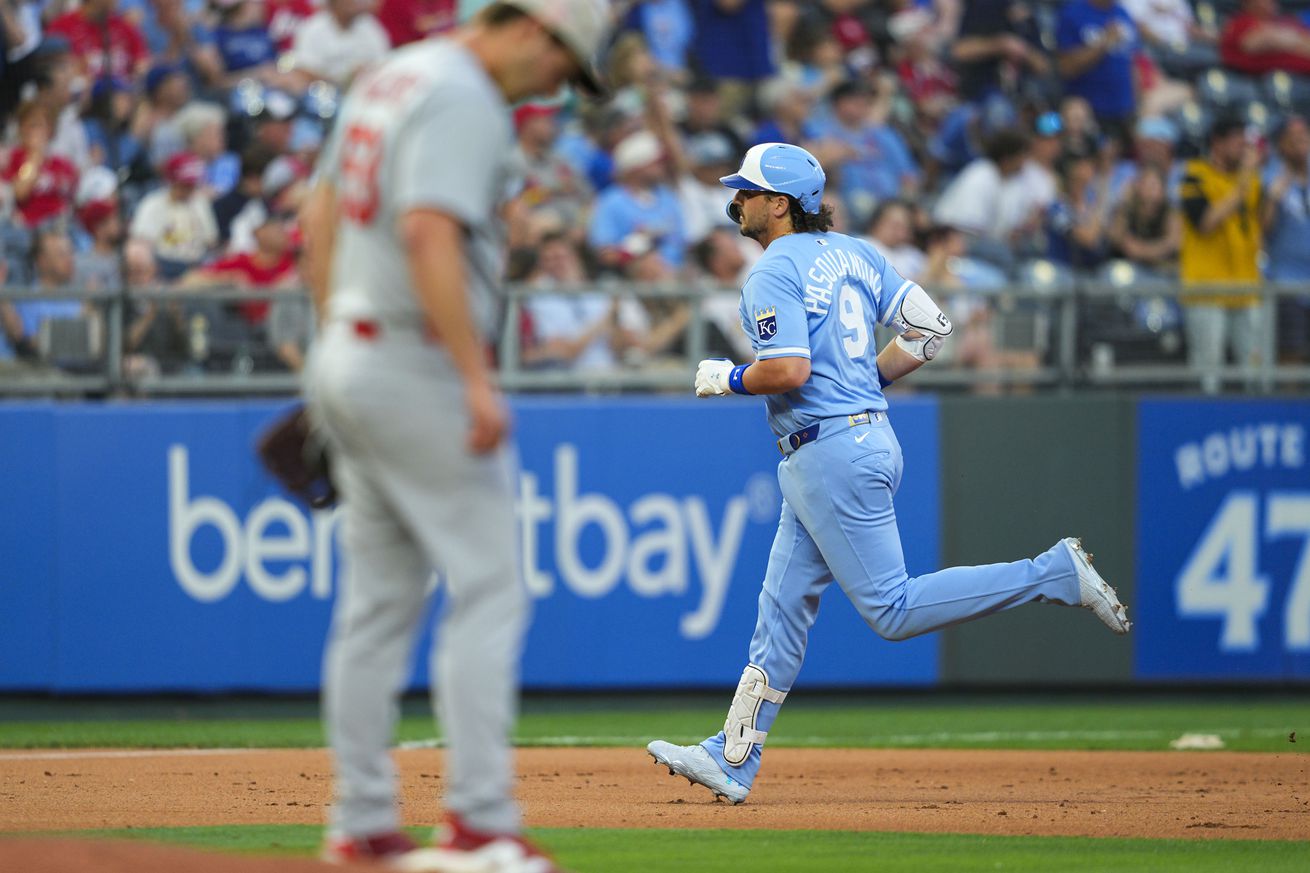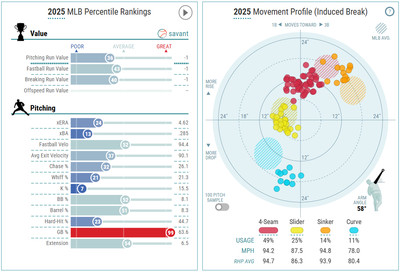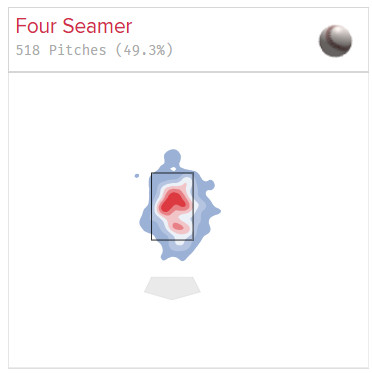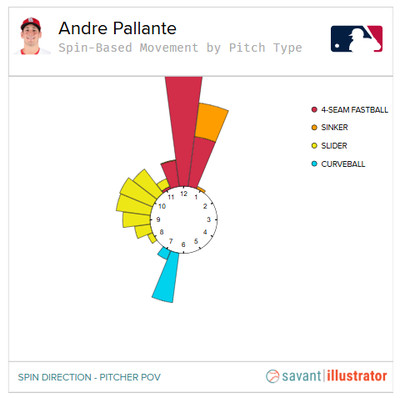
It’s been a rocky start for this young pitcher
Blake Newberry was (and maybe still is) an Andre Pallante hawk. He wrote multiple articles as this pitcher worked to establish a foothold in the major leagues, telling us that with a few tweaks, Andre could become good. As last summer unfolded, he must have been supremely satisfied to watch this young pitcher begin to establish himself as a reliable starter. Then, 2025 has happened. Why? I don’t know, so let’s take a peek.
You can reference some of these early works on Pallante here and here. The first article projects the changes Pallante would need to make. The second identified the changes he made and demonstrated in his first start (of many good ones) last year.
Fast forward 19 starts later, to the end of the 2024 season. As we took stock, it became clear that Pallante had done quite well after his recall and placement in the rotation. 20 starts, 3.78 ERA, supported by a 3.71 FIP. His 2.86 BABIP suggested a bit of good luck was involved, but that FIP seemed to predict good things ahead. He had worked hard to get his K:BB better than 2:1, which was one of the things holding him back earlier. Still to be determined was … was this a hot streak or a sign of a break-out by a pitcher who would become a rotation mainstay. Only some time on the runway would tell us.
Now fast forward again to 2025, we look up after 12 starts and see a 4.91 ERA and a 4.95 FIP. Not good. Replacement level, basically. Interestingly, his xFIP of 3.72 is quite promising, and right in line with last year. So maybe some bad luck? Well, his BABIP this year is .276, which suggests if luck is a factor, it is good luck he been experiencing. Hmmm. Then there is that extreme HR/FB rate. 25.6%, almost double the league norm. That will normalize right?
Before we begin, I’m going to forewarn you. You are not going to like the answer.
Let’s start at a high level and drill down. That sounds better than let’s just wander around the data and see what we see. His K-BB ratio is back down below 2:1, which I hold as a minimum threshold to be a decent MLB pitcher. He is slightly below instead of slightly above, so it’s difficult to pin the worse results on a marginal change unless you buy a theory that below 2:1 K-to-BB results in performance falling off a cliff. More concerning, the change in the ratio is the result of his K-rate that has dropped almost 20% (from a below average 18% in 2024 to a poor 15.5% in 2025). Swing-and-miss isn’t his game, but interestingly his Whiff rate is up a bit, even if his K-rate is down. I’m new at this, but this seems odd. He doesn’t strike enough guys out to have such a dip in K’s, because it leaves him more vulnerable to BABIP. Why are K’s down? Pitch sequencing perhaps?
Continuing to look at the things that are different between this year and last. I mean, besides the baseball card stats. Let’s look at Statcast and see if there is anything underlying. Starting with the leaderboard, you can see the 2025 and 2024 seasons below:

Data courtesy of mlb.com/statcast

Data courtesy of mlb.com/statcast
Using the left-side chart. On the surface, you can see that his FB run value has gone from high-end (96th percentile) to just below average. That is quite a drop, but even more problematic because he has never had an effective breaking ball. If I had no other data to look at, my first guess here is that his inability to develop a good curve/knuckle curve is part of the problem in the sense that he is kind of one-dimensional and if hitters can eliminate a pitch, the more they see the hard stuff, they more they catch up to it. Why now? So, I will start with theory#1 – over-exposure. We’ll explore that more thoroughly a bit later. I will go into that more but want to stay on these high-level stats for now and not lose track.
Back to the image, you can also see his barrel rate and EV have risen quite a bit this year. Will have to look deeper to find out why.
If we wander our eyes to the right-side chart, his pitches don’t seem to have changed shape much between 2024 and 2025. His pitch mix has. More sliders, traded off for less sinkers. His sinker is pretty much a pitch for RH batters only. Will have to explore if the change in pitch mix is more a function of facing more LH batters than anything else. Earlier in the year, I had noted some surprise at how managers were loading their line-ups with LH hitters, which seemed counter-intuitive given his strength in getting LH batters out. Perhaps the LH side of the league’s hitters have caught up with him. Something to look for as we move along.
There are a couple of subtle differences in pitch shape that make me wonder. First, compare the Sinker (SI) between 2024 and 2025. This year, the shape seems more erratic. It looks like he is trying to trade off vertical break to get more horizontal (arm-side) movement, but the results have been pretty varied. So, I’d say command of the Sinker is potentially an underlying issue. Especially as compared to 2024, where his Sinker really acted consistently more like a 4-seam Fastball. More rise, less arm-side run. Hard to say if the shape change is a problem or if it just the decreased command. Also, take note of the shape of his primary pitch, his Fastball. It is comparatively a straight pitch. It has a little hop (vertical break) but well below league average and has very little run or break to speak of. Keep this “straight” profile in mind for later.
Let’s look from the batter view for a moment. We can see in the Statcast view that his barrels and hard hit% is up (no kidding!), but what can we discern about that? So I peaked at some batted ball splits for the 2025 and 2024 seasons to compare.

Data courtesy of Fangraphs

Data courtesy of Fangraphs
What can you see? First thing to jump out is the number of pitches thrown to LH batters is up more than 10% from 2024, supporting an observation that managers are likely stacking in LH hitters more aggressively this year. Counter-intuitive. Some might ask if number of pitches proves that. He could be just nit-picking more to LH and throwing more pitches as a result, right? Valid, but his strike to ball ratio across the years remains constant at 3:2, so it’s batters, not pitches.
Next thing is hard contact against LH hitters is up 50% (from 24% in 2024 to 35% in 2025). It has not really changed against RH hitters. Without showing you a chart, I can tell you his ISO against LH batters is up .150 points. That is a lot, and is counter to his one elite strength, which was inducing weak, on the ground contact vs. LH hitters. Now, he still has elite ground ball rates, but many of those ground balls are getting smacked 110+ mph, so are turning into less outs. More doubles (and more homers tossed in).
And what about that HR%? That will normalize right? He is running an HR rate double league average. Well…what if I told you that this year is actually not his career high in HR%? It is quite possible that his pretty decent 9.6% HR rate last year was the outlier, and he really is a 20-25% HR rate pitcher. Gulp. Over his career, his HR rate as a starter is 20% higher than as a reliever. His HR rate against LH batters is up in 2025 (SSS ALERT!!!), consistent with batted ball metrics discussed above. He gave up 2 HR against LH batters last year in 20 starts. He is at 5 after 12 starts. Think about that for a minute. Ignore the shockingHR rate number. A simple look is … His current pace is 1 HR allowed in a typical start, which typically last 5-6 innings. This from a guy who has extraordinarily high ground ball rates. With that HR pace, throw in a few walks and some bad BABIP luck and you have yourself a crooked number inning and then you have some outings that look like … 2025. Remember, 3 runs in 6 innings is a 4.50 ERA. Where is he? Just a tad worse. The HR numbers are small enough that normalization on the HR% could well occur, but the batted ball data suggests the ISO numbers won’t without an adjustment on his end.
All this said about HR rate, we will avert our eyes at the population-wide data trend that HR rate is at an eight-year low. So Pallante’s is going up while the league is going down. Hmmm. A minor detour to SSS. Large sample sizes are less volatile. HR rate on 11 HR allowed in 12 starts is then, on other hand, very volatile. Easy to dismiss. Except that ISO is a larger sample size, not just somewhere between 2 and 5 random outcomes, and the ISO has a similar look. I’d suggest a decent likelihood that there is signal in this small sample.
So, he is getting smacked around occasionally, particularly by LH hitters. It’s not an epidemic of hard-hit balls, but enough to produce more negative than positive results. Do we know the cause? Nothing stands out on the surface except some minor pitch shape changes. Let’s continue by looking at his pitch movement profiles.

Data courtesy of Statcast
From a pitch movement standpoint, as compared to league average, he has seen some subtle shifts, nothing major. His slider has moved 20% worse (vertical movement), and also lost a bit of horizontal break. All in all, his pitch mix is below average. Was last year, and is again this year. I notice that 1⁄2 tick down in FB velo. He throws that 50% of the time. Significant? Perhaps. Think back to an earlier observation. The pitch has gotten flatter and slower. Not by great amounts,but trending the wrong way. If you look at a heat map, which you will in just a moment …

Data courtesy of Statcast
You can see from this heat map that Pallante center cuts his flat FB most of the time. When he gets it down, I suspect that turns into ground balls, but those middle-middle FB? Hmmm…Not so much. Remember, he throws this pitch 50% of the time.
Let’s explore the exposure thing again. Andre had 20 starts last year (mostly good ones) and has 12 this year (at time of writing). Is it possible he is just now starting to get exposed to teams multiple times? Kinda of like going through a line-up the third time? Which by the way, is also his kryptonite (like many average-ish pitchers). How did Pallante do so well last year. He started 20 games, against 15 different teams. So mostly, everyone saw him once. Pittsburgh saw him 3 times and KC saw him twice, as did Cincy. Not exactly powerhouse offenses, any of them. In 2025, he has seen KC twice more, with more middling results, the last 7-run outing being the worst. They are still not a juggernaut. He has now faced the Mets three times. No QS among the 3 starts, with the last one being a 3.1 IP aborted start. Without spreadsheeting it, the observational trend I see is that once teams get a look or two at him, they have more success. Also, like many, he appears more vulnerable to pitching against the stronger offenses. I didn’t realize it at the time, but last year they weaved him around the best offenses throughout the year. Now I can look back and see some the 2024 rotation re-shuffling in a different light. He went 7 or more days between starts 5 different times. Quirks of the schedule? Now, I’m wondering. The best offenses he faced last year? Houston and San Fran? Not good results when he faced them.
Taking that exposure thing to another level. Think about from a hitter’s perspective, and especially after they’ve had a chance to see his stuff in the box more than once or twice.

Data courtesy of Statcast
Here is a pretty simple game plan. These are easy enough to formulate, but become simpler to execute after you’ve seen a pitcher … their pace, their arm action, their spin, etc.
For all hitters: Ignore the knuckle-curve. It’s easy enough to spot. If you see it, take it. He can’t land it for strikes reliably, especially if they start low in the zone. Instead, as a hitter, you are sitting dead red.
For RH hitters: He is going to try and use his sinker in on you. Pitch-time decision but remember that he throws his straight Fastball 3 times more than his sinker, so take the sinker should be the default and swing only at the ones up and over the plate. Wait for his FB. It is coming. Worried about his slider? The heatmap says he keeps it out of the zone, so ignore it. Still worried? Recognize his slider spin is 90 degrees different from his other pitches, so that is a dead giveaway, if you can spot it, ignore it. It will be low and away.
For LH hitters: He is going to attack you with sliders and FB. You will not see the Sinker and if you see a Knuckle-Curve it won’t be a strike. Same advice here. Pitch-time decision between Slider and FB but remember that he throws his straight Fastball 2.5 times more than his slider, so take on the slider should be the default and swing only at the prime pitches. Again, if you as a hitter can pick up spin, the slider is 90 degrees different spin than every other pitch he has. Take, even with 2 strikes. He can’t land that slider in the zone regularly enough to worry about a K. Ergo, the low K rate. Then, wait on his straight FB. It is coming.
Let’s go one more level down.

Data courtesy of Statcast
Here is where experience facing Andre Pallante really comes in handy. His FB has good velo, and just because it is straight doesn’t mean everyone can hit it, particularly if they have to beware of Sinker (RH batters) or Slider (LH batters).
Sometimes, you just have to see and experience a pitcher’s stuff a few times to get a good read. Once a hitter has seen Pallante enough times, both LH and RH hitters can recognize and eliminate the Slider from the equation based on an almost 90-degree spin axis difference from him FB. Small wonder than he is losing his LH batter advantage. Good hitters pick this stuff up. Not all do, but good ones do. The Sinker/FB combo is well disguised (not an issue for LH hitters), but the movement profile isn’t that different (see the first chart). Both hop a bit, the sinker runs a bit more. For a RH batter, see the spin and choose location (middle-middle sounds good).
So, after a couple of looks, hitters can learn to ignore the curve and the slider. That leaves the straight fastball as his best weapon, plus a mediocre-to-average Sinker against RH hitters. Given enough chances, MLB hitters will catch up to straight fastballs.
Andre Pallante is still a young pitcher, and he may yet evolve more. So, how you see/evaluate Andre Pallante today will probably be unchanged. Some see him as a marginal 5th starter, and focus on the poor results against RH batters, too few K’s and too many walks. Some will go a step further and look at other more peripheral weaknesses, such as he is not good at controlling the running game, not a great fielder, his odd mechanics, etc. Others can continue to see potential. That elite ground ball rate remains his calling card and in front of a good defense, will keep in a lot of games. An effective off-speed breaking pitch would do wonders for his repertoire. He retired his change, I don’t know why. Maybe bring that back. Refinement of that sinker with a little more run would help mute RH hitters. A bit more separation between the shape of the 4-seamer and the 2-seamer (sinker) could be useful. All of this would allow him to rely on his FB less and likely increase its effectiveness. He has the look of a guy that might want to use his pitches more evenly instead of heavy reliance on the FB. If there is a bottom line, he is going to have to throw his non-4-seam fastballs for strikes more regularly and get out of the middle-middle with his FB. In totality, he is all of these things and today he is pitching on the wrong side of the fine line between AAA starter and #5 starter. It could change. It might not.
I wrote this article before the Blue Jays game Monday night. In that game, he went 6+, 2 R. A quality start against a lighter hitting team that hasn’t seen him much before. That is his bread-and-butter. What I really liked was an improved commitment to off-speed pitching. He even rolled out his Change-Up, which I have no idea why he quit using it in the first place.
Right now, I’d say he is at the place where he can get weak line-ups out if not over-exposed, but not good ones and he is more vulnerable the more often a line-up sees him (AB to AB and game to game). He really isn’t that different of a pitcher than 2024 (or even 2023). Luck, sequencing and exposure probably explain much of the worse outcomes he has experienced, much like how it explains his strong outcomes last year.
Do the Cardinals see it this way? Well, let’s take one data point from 2025. This weekend, they chose to pitch Gray and Fedde on normal rest but insert McGreevy to face to Dodgers and move Pallante to a lesser challenge in the Blue Jays. Accident? Purposeful? I don’t know, but I suspect more likely than not they shielded Pallante from the Dodger line-up. This bears some similarity to how they weaved him into the rotation last year. Not the kind of thing they are going to advertise. Telling everyone they’re going to a six-man rotation and want to get a look at McGreevy sounds a lot better than saying there is no way we want Andre facing the Dodger line-up. Except they didn’t go to a six-man rotation. They just bumped Pallante to the Blue Jays and promptly sent McGreevy back to AAA once they accomplished that.
Gabe suggested in his Blue Jays series preview that Pallante could be pitching for his spot in the rotation. I don’t think it is quite that dire for him, at least for a while longer. They really don’t have a good alternative. They clearly don’t want to burn the one they do have (McGreevy) and with Liberatore’s questionable status, one can see why. They may also harbor the same over-exposure concerns with McGreevy, too.
Looking down the road, say beyond end of June, or after the ASB? Hard to say. For all the talk of runways, this is a performance driven business. As in all competitions, he will have to be better. The later into the season they go, the more likely they will be comfortable replacing him with McGreevy, particularly if Mathews (or maybe Hence and/or Roby) get more established at AAA and become viewed as reliable fill-ins in case of injury/rain-out, etc.
This is only like my second deep dive on a pitcher. Debate, comments, questions and alternative theories are welcome.